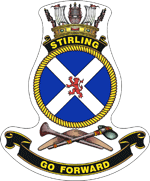History
HMAS Stirling is named after Admiral Sir James Stirling (28 January 1791 – 23 April 1865). [2] Stirling, a Royal Navy officer and colonial administrator, landed on Garden Island, Western Australia in 1827 and returned as commander of the barque Parmelia in June 1829 to establish and administer the Swan River Colony in Western Australia. He was the first Governor of Western Australia, serving between 1828 and 1838. [3]
The planning of Stirling began in 1969 when, after it was decided to create the Two-Ocean Policy, a feasibility study into the use of Garden Island as a naval base was begun. The 4.3 km (2.7 mi) causeway linking the island with the mainland was completed in June 1973. Construction of the wharves and workshops began in early 1973 and accommodation in 1975 with the facility, including the new Fleet Base West, being formally commissioned on 28 July 1978. [4]
The first major unit to call Fleet Base West home was HMAS Stuart, having first been assigned to Stirling in 1984 for several years and, after refitting in the east, again in 1988 until decommissioning in 1991. The first submarine to be based at Stirling was HMAS Oxley in 1987. Later, the headquarters of the Australian Submarine Squadron was relocated there in 1994. [2]
Stirling has expanded significantly within its existing boundaries and is the largest of the RAN's shore establishment, with a base population of approximately 2,300 service personnel, 600 defence civilians and 500 contractors. Amenities included berthing and wharves, vessel repair and refit services, a ship-lift, and a helicopter support facility, as well as medical facilities, fuel storage and accommodation. The base also hosts the Submarine Escape Training Facility – one of only six in the world and the only one in the Southern Hemisphere. [2]
Garden Island
Garden Island is 10 km (6.2 mi) in length, 1.5 km (0.93 mi) wide, and is 13 km2 (5.0 sq mi) in area, with Stirling occupying approximately 28% of that area. The remaining portion of the Island is nature reserve, the navy has been active in the removal of introduced flora and fauna species. The island has its own quarantine conditions, which prohibit bringing of plants and animals to the island. [5]
This page is based on this
Wikipedia article Text is available under the
CC BY-SA 4.0 license; additional terms may apply.
Images, videos and audio are available under their respective licenses.




